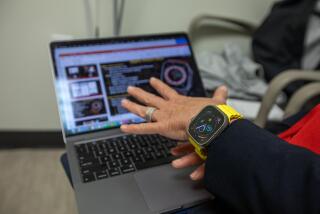Smart Houses and Bandages
- Share via
There are moments when I wonder if I’m a menace to those who know me--like the time a vision-impaired friend visiting my home had to navigate a front path strewn with half a dozen loops of garden hose, a large rock and (the piece de resistance ) a trash can filled with multiple spiky rose branches sticking out at face height. (John in Toronto, if you’re reading this: I’m very, very sorry.)
Add this to the fact that dirty dishes, in my house, have been known to fester in tepid water for days--and that one of the cats has a penchant for padding over the cutting board and snoozing on the dish rack--and you could say my house is the antithesis of one being designed by scientists at the University of Rochester in New York. Their “smart medical home” is kitted out with all kinds of high-tech gidgety gadgets aimed at improving the resident’s health.
“Our concept is to try and extend the health-care system so you can actually get care delivery in your home,” says Dr. Alice Pentland, medical director of the university’s Center for Future Technology. The clever house isn’t ready yet. For now it’s a “smart medical apartment” on campus in which sundry prototypes, still pretty bulky, are being tested.
This apartment is no slouch! And it is watching you . Stroll across the room and “gait monitor” cameras embedded in the ceiling will track the way you walk and compare it with the way you normally move. A sudden change (assuming it’s not New Year’s Eve) might be a sign of a medical problem such as a stroke that needs immediate treatment. Or for someone with a body movement disorder such as Parkinson’s disease, it might be a sign that you need to adjust your medication.
Wander over to the mirror, meanwhile, and you will be informed of far more than the fact that you just sat through a crucial business meeting with your hair sticking out like a disheveled cockatoo. Cameras behind the glass will obligingly snap pictures of your face and other areas of your body, then compare them with prior snaps.
Perhaps there’d be a false alarm or two from a bean sprout caught in a beard but such a mirror could save your life if it detected changes in a mole and thus caught skin cancer in its early, treatable stages. (For skin cancer, notes Pentland, “early detection is the cure.”)
How long have you had that milk in the fridge? Smart germ-sensing packaging can tell you it’s high time you dumped it. Is that odd-smelling chicken safe to eat? Your clever chopping board will let you know posthaste! Having memory problems? Your smart home will scan for your keys or coffee cup and find them.
And, should you have a question about which of your many pills you should be taking or why you might be getting a headache, your “conversational medical advisor” can cheerily help out. It can flash pictures of the red pill or the green pill. It can inform you if one of your medications causes headaches as a side effect.
It could even proffer advice if it senses you slipping from healthy routines--resuming smoking, perhaps, or lapsing on your daily vitamins. But any advice must be gingerly given to avoid the creation of a monster--a “nagging home,” if you will.
A truly intelligent house will know how fine a line it’s treading: “A real good solution to nagging is you turn the machine off,” Pentland notes. (Unless, of course, the chopping board gets wind of the plot and decides to mislead you about some salmonella-tainted chicken....)
Color Me Infectious
In the smart home of the future, you’ll open your medicine cabinet and take out zany, with-it bandages that change color if your wound has an infection!
Sky blue for staph? Purple for pathogenic E. coli ? Red for a bacterium resistant to antibiotics? All this and more is feasible, says Benjamin Miller, co-leader of the center’s smart bandage project. In fact, Miller and Philippe Fauchet (the center’s overall director) are well on their way to working up the concept.
For now, they’ve created a sensor that turns red if it comes into contact with a certain class of bacteria known as “gram-negative,” because their cell walls have a certain chemical structure. ( E. coli is gram negative; salmonella is too.) In a nutshell, a porous piece of silicon is studded all over with chemicals that can recognize and stick to gram-negative bugs. When the bacteria get stuck on the silicon, the pores become blocked and the silicon changes color.
Depending on how you fashion the silicon, Miller says, you could precisely detect an array of bacteria and viruses, which could lead to an array of quick tests for clinics.
But one day, Miller says, you could have a bandage with a grid of sensors that could change color in different sectors depending on what, if anything, is contaminating your flesh. Maybe it could flash messages: “Go to clinic.” “Stop malingering.” “Keep the cat out of the dish rack next time.”
*
If you have an idea for a Booster Shots topic, write or e-mail Rosie Mestel at the L.A. Times, 202 W. 1st. St., Los Angeles, CA 90012, rosie.mestel@latimes.com.






